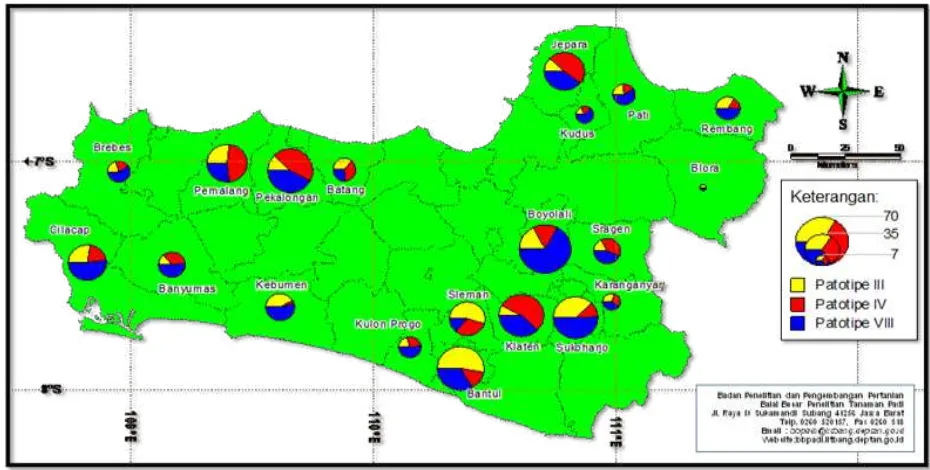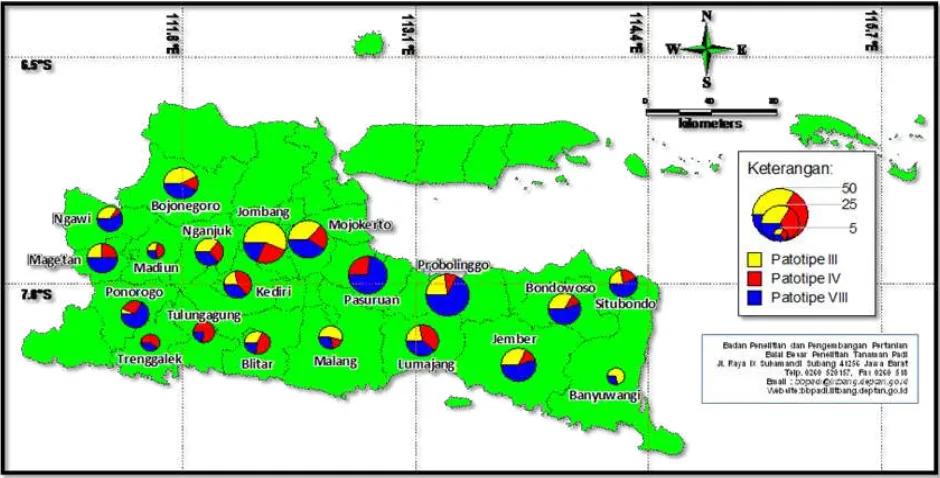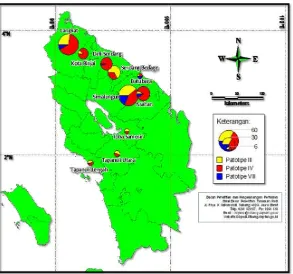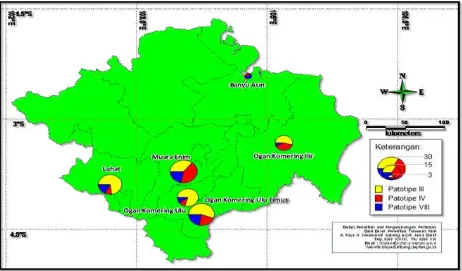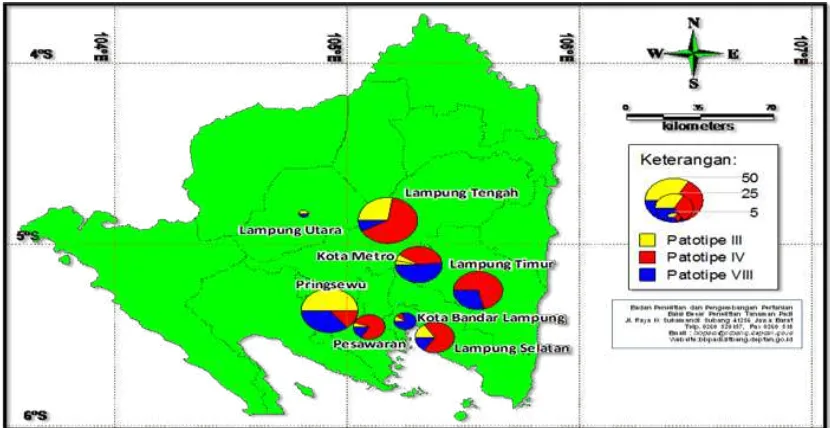COMPOSITION AND DISTRIBUTION OF
Xanthomonas oryzae
pv. o
ryzae
PATHOTYPES, THE PATHOGEN OF RICE BACTERIAL LEAF BLIGHT IN INDONESIA
Sudir *) and Dini Yuliani Indonesian Center for Rice Research
Jl. Raya 9 P.O. Box. 11, Cikampek, Subang 41256, West Java, Indonesia *) Corresponding author Email: [email protected]
Received: June 18, 2015/ Accepted: March 16, 2016
ABSTRACT
This research aimed to determine the composition and pathotype distribution of Xanthomonas oryzae pv. oryzae (Xoo) in several rice producing centers in Indonesia during the growing season of 2010-2013. The studies were conducted into three phases of activities, namely: sampling and collection of infected leaves from the representa-tive rice growing areas; isolation and purification of the Xoo isolates; and evaluation of composition and pathotype of Xoo on five rice differential varieties. Results indicated that a total of 2,658 isolates Xoo have been isolated from 10 provinces representing rice ecosystem in Indonesia during the growing season from 2010-2013. Evaluating these Xoo isolates against five differential varieties revealed that these Xoo isolates consisted of three pathotypes III, IV, and VIII with a total of 30, 36, and 34%, respectively. The data also indicated that two pathotypes III and IV were dominant in three provinces, while the pathotype VIII was dominant in four provinces. As mentioned previ-ously, such information are useful in designing strategy of integrating components of technologies combined in the management of Bacterial leaf blight (BLB) occurrences in a particular endemic areas.
Keywords: composition; distribution; rice; Xan-thomonas oryzae pv. oryzae
INTRODUCTION
Bacterial leaf blight (BLB) caused by Xanthomonas oryzae pv. oryzae (Xoo) is one of the most important diseases in many rice producing countries in Asia, including Indonesia (Suparyono et al., 2004; Jeung et al., 2006; Nayak et al., 2008). In Indonesia, this disease was found in various rice growing ecosystem and spread out
from lowlands through medium and high elevation ecosystem, and from irrigated, rainfed, dryland, and swampy agroecosystems (Suparyono et al., 2003). Generally the bacteria infect the leaf, but under favorable condition it spreads through the leaf stalk. Infection usually starts from the tip of the leaf and then evolves into the center and into the base of the leaf. Symptoms occurred in rice crop at vegetative phase called kresek and occurred at generative phase called blight (Suparyono et al., 2004). Pathogen infection causes leaf photo-synthetic function disrupted so infected plants produce more empty grains than healthy plants (Suparyono et al., 2004; Shanti et al., 2010).
Yield losses due to the disease varies between 15 and 80% depending on the crop stage when the disease arises (Reddy and Shang-zhi, 1989; Shanti et al., 2010). Qi (2009) reported in summer and autumn of 2005, epidemics of BLB were observed in China severely affecting about 28,000 hectares paddy fields (occupying 16.8% of the total rice cultivation area). In India, losses due to BLB reach from 65 to 95% (Nayak et al., 2008). Suparyono and Sudir (1992) reported that damage threshold due to BLB was ca. 20% at about two weeks before harvest. Above the threshold, each 10% increase in the BLB severity the yield losses increased by 5 to 7%.
Bacterial leaf blight is difficult to control due to its high mutability of the Xoo. New resistant varieties were easily broken down after some cropping season of exposure (Qi and Mew, 1989; Ponciano et al., 2003; Suparyono et al., 2004). The most effective strategy to control BLB was previously considered to be the use of resistant varieties. Unfortunately this strategy was challanged by the mutability of the Xoo patho-types which were able to break down the resistant varieties. The application of this technology became limited by time and location. There were a total of 11 groups of Xoo pathotype reported Cite this as: Sudir and D. Yuliani. 2016. Composition and distribution of Xanthomonas oryzae pv. oryzae pathotypes, the pathogen of rice bacterial leaf blight in Indonesia. AGRIVITA Journal of Agricultural Science. 38(2): 174-185 Doi: 10.17503/agrivita.v38i2.588
Accredited : SK No. 81/DIKTI/Kep/2011
by Hifni and Kardin (1998), and there were three dominant Xoo pathotypes, i.e.: III, IV and VIII (Sudir et al., 2009).
The diverse of Xoo pathotypes also cause resistant varieties in a season at one site could be susceptible in different season at the other places (Suparyono et al., 2003; Suparyono et al., 2004; Qi, 1995; Hoang et al., 2008). Period of time, a resistant varieties become susceptible (fracture resistance) was determined by several factors, including the composition and domi-nance, the speed of pathotype changing, planting frequency, and the composition of varieties with different genetic backgrounds were planted in a certain of time and place (Ogawa, 1993; Suparyono et al., 2004; White and Yang, 2009). Resistant varieties will break its resistance to BLB pathogens when planted for three to four seasons consecutively (Sudir and Suprihanto, 2006). Rotation of resistant varieties to control BLB disease need to be designed carefully, as the resistant varieties can last longer in the field. This tactic requires the support of various data, especially with regard to Xoo pathotype profile in an agroecosystem and the resistance back-ground of varieties to be planted.
Monitoring of composition, dominance, and Xoo pathotype distribution in a region and searching for new resistance genes need to be done as one of the BLB control strategy. This research aimed to determine the composition, dominance, and distribution of Xoo pathotype in rice producing centers in Indonesia.
MATERIALS AND METHODS
This research was conducted during the growing season from 2010 to 2013. The research activities were classified into three stages, i.e.: 1) Sample collection of rice leaves showing the symptom of BLB, 2) Isolation of Xoo isolates from these collected diseased leaves, and 3) Identification of Xoo pathotype on five rice differential varieties in the green house.
Sample Collection of Rice Leaves Showing the Symptom of Bacterial Leaf Blight
Observations and sampling of diseased leaves were carried out from several rice planting location in North Sumatera, South Sumatera,
Yogyakarta Special Province, East Jawa, South Sulawesi, and West Nusa Tenggara. These ten provinces were selected as the site representing the development and composition of pathotype of Xoo as they are considered to be the main rice-producing areas in Indonesia where the disease is endemic. Depending on the availability of the rice crop stages, samples were taken from three to five districts per province, and from three sub-districts per district. Based on the paddy crop stages two diseased leaves showing BLB symptoms per hill were taken from 20 hills of approximately 0.1 to 0.5 ha of sampling site.
Each sampling site of the rice fields was arbitrarily divided into three parts, each was designated as replicates. Sampling hills were diagonally assigned as the five sample points, from which diseased leaves were sampled. Samples were wrapped in a paper envelope. Notes indicating location, rice varieties, plant growth stage, sampling date, and disease severity, were established. Samples were then taken into the laboratory for the 2nd steps of activities of the experiment, i.e.: isolation of Xoo. Isolation of Xanthomonas oryzae pv. oryzae
Identification of Xanthomonas oryzae pv. oryzae Pathotype
1. Differential Varieties and Experimental Design. Identification of pathotype of Xoo isolate was done based on the interrelation-ship between the bacteria isolates and five rice differential varieties. In this study, five differential varieties possesing different genetic background, namely Kinmaze, Kogyoku, Tetep, Wase Aikoku, and Java 14, were utilized. Kinmaze does not posses resistant gene; Kogyoku posses two dominant resistance genes (Xa-1, and Xa-12); Tetep soils enriched with organic manures and NPK fertilizers. One of the 15-day old seedling was transplanted to a pot. The plants were irrigated 1-2 times/day and were fertilized with urea, phosphorous, and potassoium at the rates of 1.56, 0.63, and 0.31 g per pot respectively. The experiments were arranged in a randomized block design. Experimental units consisted of 15 pots/isolate with one hill/pot.
2. Inoculum and Inoculation Procedures Isolates of Xoo were isolated from naturally diseased leaves collected from 10 provinces of rice growing centers. Inoculum was prepared by transferring approximately 1 cc of the diluted Xoo streaked in petri plates containing potato sucrose agar (PSA) medium. Cells from two day-olds PSA cultures were suspended in a 0.1 M NaCl buffer solution and adjusted to 108 cfu per ml. Inoculation of Xoo isolates were conducted in a glass house using five rice differential varieties. Rice plants at the maximum tillerring stage were inoculated 5 cm from the tip of the leaf. Inoculations of Xoo suspension were done by wounding the leaves through clipping method (IRRI, 2014).
3. Disease Rating and Identification of Pathotype. Disease severity were measured on leaf basis at two to four weeks after
inoculation by measuring the length of symptoms developed on each differential variety. Disease severity value was obtained as the ratio between the length of leaves with symptoms and the length overall leaves. Mean disease ratings were converted into percentages by taking value of each leaf and performed in percentage (%). Resistance reaction of each differential variety was classified as resistant (R) when the mean severity value on the differential variety was
≤11%, and as susceptible (S) when the mean severity value was ≥ 12 % (Suparyono et al., 2003). Pathotype of Xoo was determined based on Kozaka system. Pathotype of Xoo was grouped based on interaction between the Xoo isolates tested and five rice differential varieties (Table 1). Pathotype III was high virulent against Kinmaze, Kogyoku, and Tetep but low virulent against Wase Aikoku and Java 14. Pathotype IV was virulent to all Japanese differential varieties. While pathotype VIII was high virulent against Kin-maze, Kogyoku, Tetep, and Wase Aikoku but low virulent against Java 14 (Sudir et al., 2009). The data were presented in the form of map composition and distribution of the existing pathotype.
RESULTS AND DISCUSSION
Table 1. Pathotype grouping of X. oryzae pv. oryzae isolates based on interaction between the X. oryzae pv. oryzae isolates and five rice differential varieties
No. Differential variety Resistance Genes Differential variety*Xoo isolate interaction
1 Kinmaze None S S S S S R S S S S S R
2 Kogyoku Xa-1, Xa-12 R S S S R R S S S R S R
3 Tetep Xa-1, Xa-2 R R S S R S S S R S R R
4 Wase Aikoku Xa-3 (Xa-12) R R R S S R R S S S S S
5 Java 14 Xa-1, Xa-2, and Xa-12 R R R S R R S R R R S R
Xoo Pathotype Grouping I II III IV V VI VII VIII IX X XI XII
Remarks: R=resistance, disease severity ≤11%; S = susceptible, disease severity ≥12% (Sudir et al., 2009)
Table 2. Composition and domination of X. oryzae pv. oryzae pathotype in 10 rice producing centers in Indonesia
No. Province Xoo Isolates Xoo Pathotype Groups
III (%) IV (%) VIII (%)
1 West Java 624 181 (29) 204 (33) 239 (38)
2 Banten 68 18 (26) 11 (16) 39 (57)
3 Central Java 517 114 (22) 158 (31) 245 (47)
4 D.I. Yogyakarta 107 52 (49) 23 (21) 32 (30)
5 East Java 348 101 (29) 88 (25) 159 (46)
6 South Sulawesi 176 102 (58) 41 (23) 33 (19)
7 North Sumatera 245 72 (32) 150 (58) 23 (10)
8 South Sumatera 116 67 (58) 28 (24) 21 (18)
9 Lampung 225 48 (21) 112 (50) 65 (29)
10 West Nusa Tenggara 232 47 (20) 118 (51) 67 (29)
Total 2,658 802 (30) 933 (36) 923 (34)
In West Java Province, a total of 624 isolates obtained from 10 districts representing rice producing. These isolates consisted of 181 isolates (29%) pathotype III, 204 isolates (33%) pathotype IV, and 239 isolates (38%) pathotype VIII (Figure 1). Xoo pathotype III found dominated in five districts i.e. Cianjur, Sukabumi, Tasikma-laya, Kuningan, and Bogor; pathotype IV dominated in four districts i.e. Karawang, Indramayu, Cirebon, and Bekasi; whilepathotype VIII dominated in two districts i.e. Subang and Indramayu. It appeared that the existing patho-type VIII dominated in West Java Province.
From Banten Province, a total of 68 Xoo isolates collected from four sampling districts. Compositions of the isolates were 18 (26%) isolates as pathotype III, 11(16%) isolates as pathotype IV, and 39 (57%) isolates as pathotype VIII (Figure 1). In this province, pathotype VIII dominated in four districts i.e. Serang,
Rangkas-bitung, Lebak, and Pandeglang; pathotype III and IV distributed in nearly uniform in the four districts observed. Generally appeared that the existing isolates of Xoo in Banten Province identified as pathotype VIII.
Figure 1. Distribution mapping of X. oryzae pv. oryzae pathotype in West Java and Banten Provinces
Figure 2. Distribution mapping of X. oryzae pv. oryzae pathotype in Central Java and Yogyakarta Provinces
In Special Province of Yogyakarta, a total of 107 Xoo isolates collected from the three representing districts. These isolates consisted of 52 (49%) isolates pathotype III, 23 (21%) isolates pathotype IV, and 32 (30%) isolates pathotype VIII (Figure 2). Xoo pathotype III dominated in two
While in East Java Province, a total of 348 Xoo isolates obtained from 21 districts sampled in East Java. These isolates consisted of 101 (29%) isolates pathotype III, 88 (25%) isolates pathotype IV, and 159 (46%) isolates pathotype VIII (Figure 3). The data indicating that Xoo pathotype III dominated in four districts i.e. Jombang, Banyuwangi, Malang, Nganjuk, and Bojonegoro. Xoo pathotype IV dominated in six districts i.e. Lumajang, Blitar, Tulungagung, Trenggalek, Madiun, and Kediri. Xoo pathotype VIII dominated in 13 districts, i.e. Mojokerto, Pasuruan, Probolinggo, Lumajang, Situbondo, Bondowoso, Jember, Ponorogo, Magetan, Ngawi, Mojokerto, Nganjuk, and Bojonegoro. It was shown that Xoo pathotype VIII dominated in East Java Province.
South Sulawesi Province. A total of 176 Xoo isolates were obtained from the 10 districts sampled in South Sulawesi. These isolates consisted of 102 (58%) isolates pathotype III, 41 (23%) isolates pathotype IV, and 33 (19%) isolates pathotype VIII (Figure 4). Xoo pathotype
III dominated in eight districts i.e. Bone, Soppeng, Wajo, Sidrap, Barru, Pangkep, Pinrang, and Luwu; Xoo patotipe IV dominated in Maros district; and Xoo patotipe VIII dominated in Palopo district. The data indicated that except in the two districts i.e. Maros and Palopo, Xoo pathotype III dominated pathotype in all districts of South Sulawesi.
From North Sumatra Province, a total of 245 Xoo isolates obtained from 10 districts sampled in North Sumatera Province. These isolates consisted of 72 (32%) isolates pathotype III, 150 (58%) isolates pathotype IV, and 23 (10%) isolates pathotype VIII (Figure 5). Xoo pathotype III dominated in four districts i.e. Serdang Bedagai, North Tapanuli, South Tapanuli, and Toba Samosir; Xoo patotipe IV dominated in seven districts i.e. Deli Serdang, Binjai, Langkat, Simalungun, Asahan, Central Tapanuli, and Toba Samosir; and Xoo patotipe VIII dominated in Batubara district. It appeared that Xoo pathotype IV dominated in North Sumatra Province.
Figure 4. Distribution mapping of X. oryzae pv. oryzae pathotype in South Sulawesi Provinces
From South Sumatra Province, a total of 116 Xoo isolates were successfully collected from 6 districts of South Sumatera. These isolates consisted of 67 (58%) isolates as patho-type III, 28 (24%) isolates as pathopatho-type IV, and 21 (18%) isolates as pathotype VIII (Figure 6). Xoo pathotype III dominated in four districts i.e. Ogan Komering Ilir, Ogan Komering Utara, Ogan Komering Ulu, and Lahat. Xoo patotipe IV dominated in Muara Enim district, while Xoo patotipe VIII dominated Banyuasin district. The data indicated that pathotype VIII dominated in South Sumatra Province.
Lampung Province. A total of 225 Xoo isolates were obtained from 8 districts of Lampung province. These isolates consisted of 48 (21%) isolates as pathotype III, 112 (50%) isolates as pathotype IV, and 65 (29%) isolates as pathotype VIII (Figure 7). Xoo pathotype III dominated in two districts i.e. Pringsewu and North Lampung
Utara, Xoo patotipe IV dominated in four districts i.e. Lampung Tengah, South Lampung, East Lampung, and Pesawaran. Xoo patotipe VIII dominated in three districts i.e. North Lampung, Metro, dan Bandar Lampung. It revealed that Xoo pathotype IV dominated in Lampung Province.
West Nusa Tenggara Province. A total of 232 Xoo isolates have been successfully isolated from 6 districts of West Nusa Tenggara. These isolated consisted of 47 (20%) isolates as pathotype III, 118 (51%) isolates as pathotype IV, and 67 (29%) isolates pathotype VIII (Figure 8). Xoo pathotype III dominated in Central Lombok district; Xoo patotipe IV dominated in four districts i.e. West Lombok, East Lombok, Mataram, and Sumbawa; and Xoo patotipe VIII found dominated in North Lombok district. The data indicated that Xoo pathotype IV dominated in Lampung Province.
Figure 7. Distribution mapping of X. oryzae pv. oryzae pathotype in Lampung Provinces
Figure 8. Distribution mapping of X. oryzae pv. oryzae pathotype in West Nusa Tenggara Provinces Based on the interaction between various
Xoo isolates collected from different rice growing centers and the differential varieties possesing different genetic background for resistant to the Xoo bacteria, a distinct variation of reactions were observed. The observation indicated that Xoo isolates in Indonesia consisted of pathotype III, IV, and VIII in which their composition and dominance varied by location. Xoo pathotype III were highly virulent to the Kinmaze, Kogyoku, and Tetep, but were low virulent to Wase Aikoku and Java 14. Xoo pathotype IV was Xoo highly
virulent to all differential varieties, while Xoo pathotype VIII were those Xoo isolates that were highly virulent to Kinmaze, Kogyoku, Tetep, and Wase Aikoku, but were low virulent to Java 14. Suparyono et al., (2003) reported that pathotype IV was more virulent than the two pathotypes VIII and III.
pathotype VIII was most dominant and a very wide distribution area both in the lowlands and moderate. Meanwhile, Xoo pathotypes III and IV were pathotypes contained in certain areas, particularly in the lowlands.
Hifni (1995), also reported that during 1980s, Xoo pathotype in Indonesia was dominated by pathotype III, The dominance was replaced by pathotype IV in the early of 1990s. Suparyono et al., (2004), reported in the early of 2000s, Xoo bacterial population in Java dominated by pathotype VIII. Although quantitatively was different, it was apparent that pathotype VIII dominated in all locations except in Yogyakarta province. Data obtained from this research were consistent with the results reported by Suparyono et al., (2004). This report showed that Xoo patho-type VIII dominated in Java. These information revealed that during the period of 2004-2007 the dominance of Xoo pathotype in Java Island has not changed. Based on the results of this research, breeding programs in Indonesia in the future, the selection of rice germplasm, and evaluation of promising lines should be directed to obtain the varieties that resistant to the three pathotypes, especially VIII.
Several factors that influence pathotype variation and changes such as adult-plant resistance, mutation, and heterogeneous nature that existing in the pathogen population (Agrios, 1988). All three of these factors greatly influence the pathotype population dynamics, disease severity, and yield losses due to disease (Suparyono et al., 2003). Hwang et al., (1987), defined adult-plant resistance as the resistance properties that appear when the plant had reached the generative phase. Resistance properties which appear on the plant at generative phase influence Xoo populations. A similar phenomenon may occur as a result of the mutation process. Another possibility was a character existence that is natural heterogeneity of a microorganism’s population. Sudir and Suprihanto (2008), reported that the growth stages of rice plants affect the diversity of Xoo pathotype composition. Pathotypes III, IV, and VIII were found during tillering, flowering, and ripening growth stages of the rice plants. Pathotype VIII was dominant in the growth phase of tillering and flowering, while Xoo pathotype III
emergence of a new Xoo pathotype development as single resistant variety cropping result in very strong selection pressure which causes the fracture of varieties resistance (Ogawa, 1993; Semangun, 1995). Diversity of Xoo pathotype composition was also influenced by the composition of rice varieties that were grown (Suparyono et al., 2003). During the planting period of 2010-2013, the rice varieties grown by farmers were dominated by Ciherang (47.0%), IR64 (19.7%), local varieties (6.8%), and other varieties (4.0%).
Environmental factors, such as wet and dry seasons affect the pathotype diversity of Xoo. Suparyono et al., (2003) in the dry season of 2001, revealed that a balanced existence of Xoo pathotypes III and VIII were observed, at the proportion of 42.7 and 42.0%, respectively in West Java, Central Java, Yogyakarta Special Province, and East Java. In the following season, was during the rainy season of 2001/2002, the balanced existance of Xoo groups III and VIII, was no longer exist. It has changed, in which the pathotype VIII was dominant, followed by pathotype IV and III, with the proportion of 63, 29, and 9%, for pathotype VIII, IV, and III, respect-ively. Changes in virulence were likely influenced by environmental conditions, especially relative humidity (RH). Xoo Bacteria thrive in conditions of high humidity (≥90%) and temperature between 25-30oC (Ou, 1985).
Information obtained from this research were expected to be useful as a guide to varieties zoning strategy in rice producing centers in Indonesia as a basis for recommendation of planting resistant varieties for BLB disease control according to Xoo pathotype that presence in the field. For example, in endemic areas of Xoo pathotype III was recommended planting varieties that were resistant to Xoo pathotype III. The same recommendation also can be applied for endemic areas of Xoo pathotype IV and VIII.
especially during the wet season which was very favorable for the development of bacterial leaf blight disease, should be planted rice varieties that had resistance to Xoo pathotype III, IV, and VIII such as the varieties of Angke, Conde, Ciujung, Inpari 6 Jete, and Inpari 17 (ICRR, 2013). A variety as a host of pathogens is one of the elements that determine the epidemic. Host who has a high level of resistance does not provide opportunities for pathogens to thrive (Zadoks and Schein, 1979). Suitability planting of varieties with pathotype of pathogens in a region, a positive impact on the effectiveness of BLB disease control, so that disease can be suppressed, duration of varieties resistance against BLB disease can be extended, yield losses can be reduced, and farmers' income can be increased (Sudir et al., 2009).
CONCLUSIONS AND SUGGESTIONS
Based on virulence against five differential varieties, Xoo isolates in Indonesia consists of three pathotypes III, IV, and VIII with a diverse composition and distribution between sites. In general, from 2,658 Xoo isolates that isolated from 10 rice producing provinces in Indonesia obtained 802 isolates (30%) pathotype III, 933 isolates (36%) pathotype IV, and 923 isolates (34%) pathotype VIII. Xoo pathotype III was dominant in the Provinces of Yogyakarta, South Sulawesi, and South Sumatra. Xoo pathotype IV was dominant in the provinces of North Sumatra, Lampung, and West Nusa Tenggara. Xoo pathotype VIII was dominant in West Java, Banten, Central Java, and East Java.
Mapping of Xoo pathotype composition and distribution in 10 provinces in Indonesia can be used as a reference to control bacterial leaf blight disease with resistant varieties based on the relationship between the nature of varieties resistant to Xoo pathotype in the field. In the area with dominant of Xoo pathotype III was recommended to planting varieties that were resistant to Xoo pathotype III such as Memberamo, Cibodas, Ciherang, Sintanur, Cigeulis, Inpari 5, Inpari 6, Inpari 7, Inpari 8, and Inpari 16 until Inpari 28. In the dominant area of Xoo pathotype IV suggested to plant resistant varieties against Xoo pathotype IV such as Ciujung, Conde, Angke, Inpari 1, Inpari 6, and Inpari 17. In the dominant area of Xoo VIII pathotype suggested to plant resistant varieties
against Xoo pathotype VIII such as Conde, Angke, Inpari 1, Inpari 4, Inpari 6, Inpari 17, and Cimelati.
ACKNOWLEDGMENTS
The authors would like to thanks to Mr. Suwarji and Mr. Umin Sumarlin for technical work in the laboratory and the field. The authors also thanks to Dr. Suparyono and Dr. Aris Hairmansis were willing to review this article. Sincerely thank to Indonesian Center for Rice Research for supporting funds and facilities.
REFERENCES
Agrios, G.N. 1988. Plant pathology, 3rd edition. New York: Academic Press. p. 713. Hifni H.R. 1995. Variations of bacterial leaf blight
pathogen in Indonesia (in Indonesian). In: Performance Food Crop Research. Bogor: Indonesian Center for Food Crops Research and Development. p. 16. Hifni, H.R. and M.K. Kardin. 1998. Grouping of
Xanthomonas oryzae pv. oryzae isolates using IRRI near-isogenic lines of rice (in Indonesian). Hayati 5 (3): 66-72.
Hoang, D.D., N.K. Oanh, N.D. Toan, P.V. Du and L.C. Loan. 2008. Pathotype profile of Xanthomonas oryzae pv. oryzae isolates from the rice ecosystem in Cuulong Rever Delta. Omonrice 16: 34-40. Hwang, B.K., Y.J. Koh and H.S. Chung. 1987.
Effects of adult-plant resistance on blast severity and yield of rice. Plant Disease 71 (11): 1035-1038. doi: 10.1094/PD-71-1035
ICRR. 2013. Description of rice new varieties(in Indonesian). Indonesian Center for Rice Research. Indonesian Agency for Agri-cultural Research and Development. Ministry of Agriculture. p. 65.
IRRI. 2014. Standard evaluation system for rice, 5th edition. INGER Genetic Resources Center. Los Banos: The International Rice Research Institute. p. 57.
Nayak, D., M.L. Shanti, L.K. Bose, U.D. Singh and P. Nayak. 2008. Pathogenicity association in Xanthomonas oryzae pv. oryzae the causal organism of rice bacterial blight disease. Journal of Agri-cultural and Biological Science 3 (1): 12-27.
Ogawa, T. 1993. Methods and strategy for monitoring race distribution and identi-fication of resistance genes to bacterial leaf blight Xanthomonas campestris pv. oryzae in rice. Japan Agricultural Re-search Quarterly 27 (2): 71-80.
Ou, S.H. 1985. Rice diseases, 2nd edition. UK: Commonwealth Agricultural Bureaux. p. 380.
Ponciano, G., H. Ishihara, S. Tsuyumu and J.E. Leach. 2003. Bacterial effectors in plant disease and defense: keys to durable re-sistance? Plant Disease 87 (11): 1272-1282. doi: 10.1094/PDIS.2003.87. 11. 1272
Qi, Z. and T.W. Mew. 1989. Types of resistance in rice to bacterial blight. Proceedings of the International Workshop on Bacterial Blight of Rice. March 14-18, 1988. Philippines: International Rice Research Institute. pp. 125-134.
Qi, Z. 1995. Utilization and strategy of gene for resistance to rice bacterial blight in China. Journal of Plant Protection 19: 453-459. Qi, Z. 2009. Genetics and improvement of
bacterial blight resistance of hybrid rice in China. Rice Science 16 (2): 83-92. doi: 10.101 6/S1672-6308(08)60062-1
Reddy, R. and Y. Shang-zhi. 1989. Survival of Xanthomonas campestris pv. oryzae, the causal organism of bacterial blight of rice. Proceedings of the International Work-shop on Bacterial Blight of Rice. March 14-18, 1988. Philippines: International Rice Research Institute. pp. 65-78. Semangun, H. 1995. Concepts and basic
prin-ciples of integrated plant disease management (in Indonesian). Proceed-ings of the XII National Congress and Scientific Seminar of Indonesian Phyto-patology Association. September 6-8, 1995. Yogyakarta. pp. 1-24.
Shanti, M.L., G.L. Devi, G.N. Kumar and H.E. Shashidhar. 2010. Molecular
marker-assisted selection: a tool for insulating parental lines of hybrid rice against bacterial leaf blight. International Journal of Plant Pathology 1 (3): 114-123. doi: 10.3923/ijpp.2010.114.123
Sudir and Suprihanto. 2006. Changes in strains virulence of Xanthomonas oryzae pv. oryzae, causing of bacterial leaf blight in rice plants (in Indonesian). Jurnal Pene-litian Pertanian Tanaman Pangan 25 (2): 100-107.
Sudir and Suprihanto. 2008. The relationship bet-ween the population of bacteria Xantho-monas oryzae pv. oryzae with bacterial leaf blight disease severity in some rice varieties (in Indonesian). Jurnal Pene-litian Pertanian Tanaman Pangan 27 (2): 68-75.
Sudir, Suprihanto and T.S. Kadir. 2009. Patho-type identification of Xanthomonas ory-zae pv. oryzae, causing bacterial leaf blight in rice production centers in Java (in Indonesian). Jurnal Penelitian Perta-nian Tanaman Pangan 28 (3): 131-138. Suparyono and Sudir. 1992. Bacterial leaf blight
disease progression at different growth stage and its effect on rice yield (in Indonesian). Media Penelitian Suka-mandi 12: 6-9.
Suparyono, Sudir and Suprihanto. 2003. Compo-sition pathogenic pathotype of bacterial leaf blight in rice plants at grow different stadia (in Indonesian). Jurnal Penelitian Pertanian Tanaman Pangan 22 (1): 45-50.
Suparyono, Sudir and Suprihanto. 2004. Patho-type profile of Xanthomonas oryzae pv. Oryzae isolates from the rice ecosystem in Java. Indonesian Journal of Agri-cultural Science 5 (2): 63-69.

